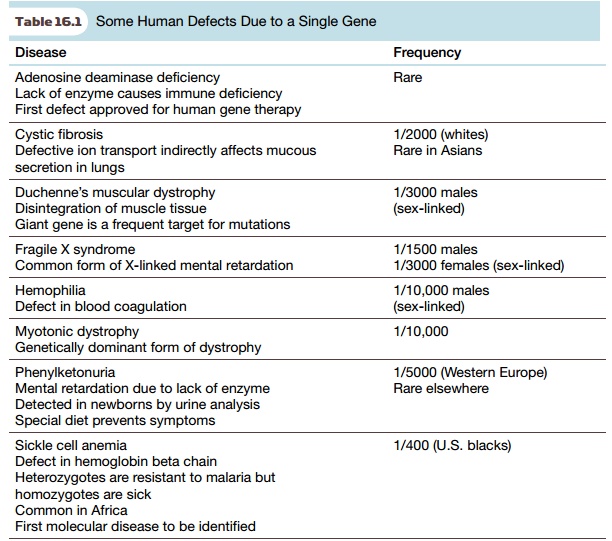Chapter: Biotechnology Applying the Genetic Revolution: Inherited Defects
Hereditary Defects in Higher Organisms
HEREDITARY DEFECTS IN HIGHER ORGANISMS
If the DNA of a single-celled
organism is mutated, the mutation will be passed on to all of its descendants
when it divides. The situation in multicelled creatures is more complex. In
animals, the germline cells are reserved for reproductive purposes and give
rise to the eggs and sperm in mature adults. The somatic cells forming the rest
of the body are not passed on to the next generation. However, mutation of
somatic cells is involved in cancer.

Higher organisms such as
animals and plants are normally diploid and have two copies (i.e., two alleles)
of each gene. Therefore, if one copy is damaged by a mutation, the other copy
can compensate for the loss. Because most mutations are relatively rare, it is
unlikely that both alleles of the same gene will carry mutations. Furthermore,
most detrimental mutations are recessive to the wild type (Fig. 16.1 and Table
16.1). That is, a single functional allele is sufficient for normal growth and
the defective copy has no noticeable effect on the phenotype.
Nonetheless, we humans all
have quite a few mutations randomly scattered among our 25,000 genes.
Obviously, close relatives tend to share many defects. Individuals share half
of their genetic information with their brothers, sisters, father, and mother,
although, of course, not the same half with each of them. Therefore, a child
from the mating of close relatives (for example, as in brother/sister or
father/ daughter), has a much increased chance of getting two copies of the
same defect, that is of being homozygous for the recessive allele (Fig. 16.2).

Mating between close
relatives, even cousins, makes genetic disease more likely. This is because a
rare recessive allele present in one ancestor may be passed down both sides of
the family and two copies may end up in one particular child. In Europe, royal
families insisted that their children marry other royalty; therefore, many
marriages were between closely related individuals. This led to a high
incidence of defects among the offspring, the best known being hemophilia. In
marriages between unrelated people, recessive diseases will only affect the
children if by chance an ancestor from each side of the family carried a copy
of the defective allele. This is the underlying reason for the taboos against
incest, which prevail in most societies, though the degree of forbidden
relationships varies considerably between different cultures.
Many genetic defects are
fatal to sperm cells, fertilized eggs, or early embryos so they are never seen
in adults. Nevertheless, a wide range of genetic defects has been observed in
living humans. Some of the most common defects due to a single gene are listed
in Table 16.1. Unless otherwise noted, they are recessive and require both
alleles to be defective for symptoms to appear. Large genes are bigger targets
for random mutation. The genes responsible for cystic fibrosis, muscular
dystrophy, and phenylketonuria are all abnormally large and all three genetic
defects are relatively common.

Related Topics